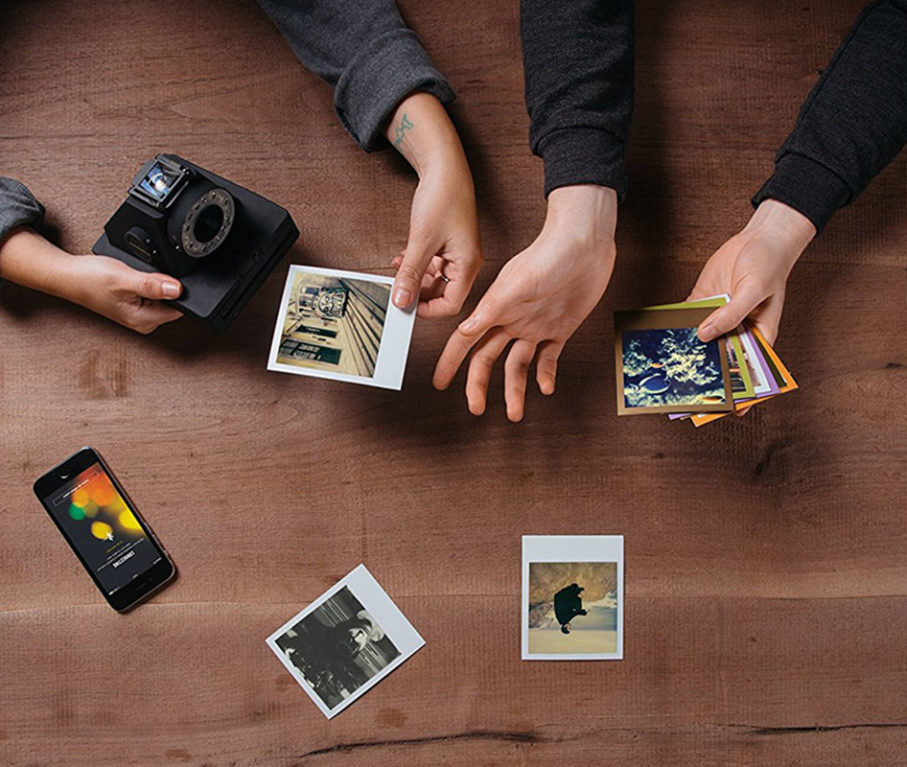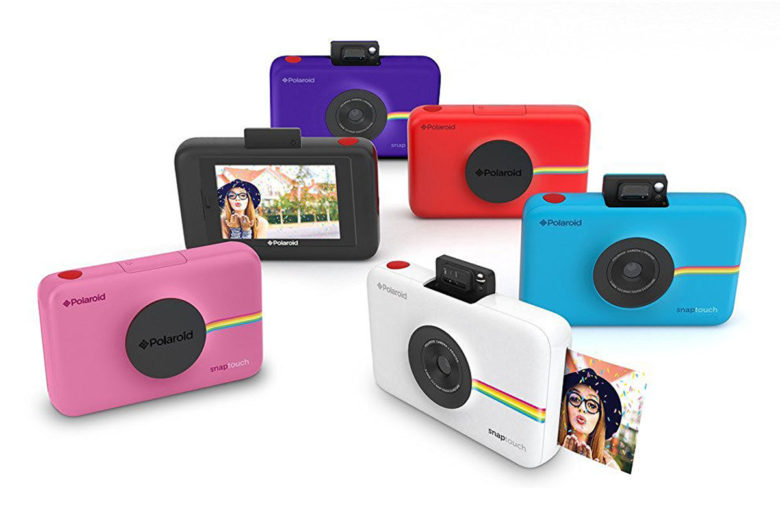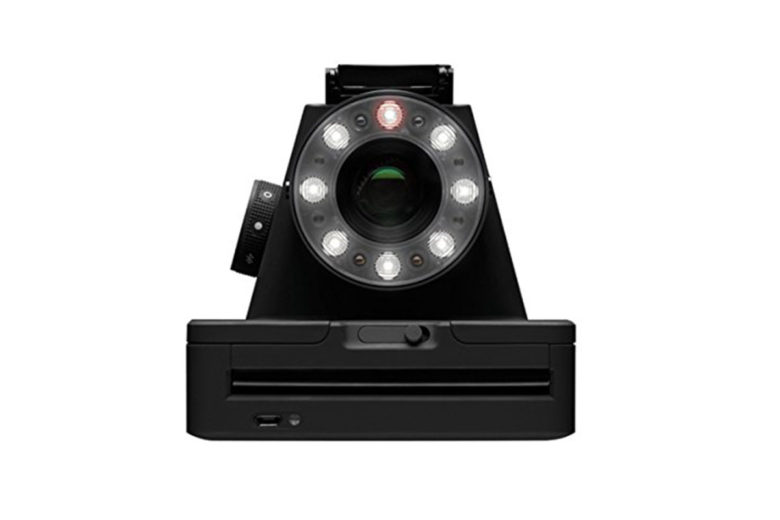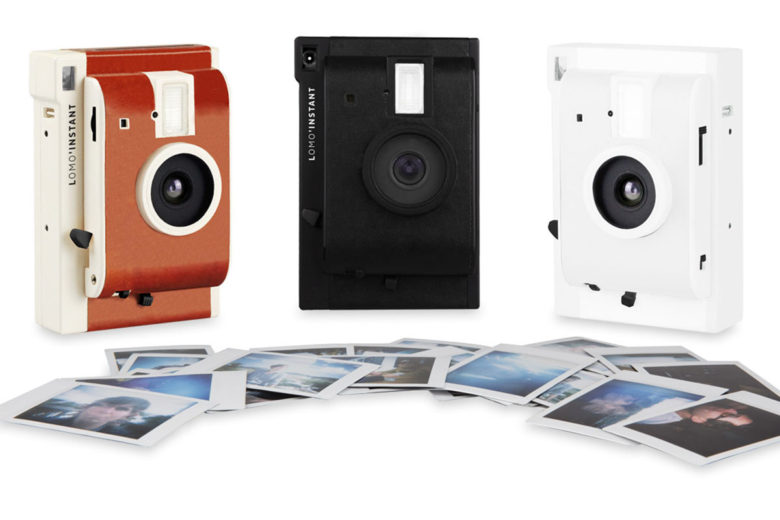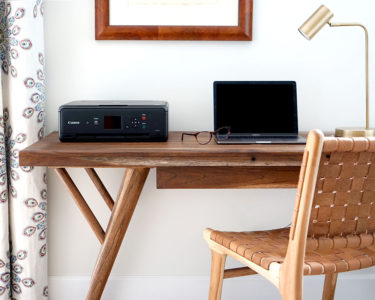Trigger-happy with my smartphone camera? Guilty. I’m always ready to grab an action shot of my dog, my kids, my lunch… but I can’t help but feel that there’s something lost with all these pictures that only exist in digital space. As much as physical pictures were a bear to store, keep organized (and safe from basement floods), I do miss the the visceral nature of flipping through photos.
Naturally, the resurgence of instant cameras really appeals to me. Not only do they offer immediate print gratification, but they’re a welcome respite from screens. Plus there’s something meditative about waiting for them to magically develop in your hand. Waiting, remember that? And think of the ways you can decorate with them: How about a photo garland, or a tree decked out in instant photos that family members take on the spot?
We’ve come a long way since Ye Old Polaroids that smelled a little funky and sometimes came out greenish. Though Polaroid is back, it’s a whole new landscape, complete with competition from FujiFilm, Lomography and others getting in on the instant action. We compared four of the newest instant cameras— read on to see what develops (ahem).
Polaroid Snap
The Polaroid Snap is a 10 megapixel digital camera with a built-in printer. It takes color, black-and-white and sepia photos, and the option to include a border or print four mini prints on one paper (share with friends!). What really sets it apart from the pack is ZINK technology, which means pics will come out completely developed and fill the entire 2″x 3” photo sheet. The Snap has a USB charger with a built-in rechargeable lithium battery— its competitors need store-bought batteries.
With a smooth, matte body, pop-up flash and flush lens, the Snap has the sleekest design of any of the devices I tested. Its rounded edges and evenness almost look like candy (think Jordan almond). It comes in black, white, blue and red. Oh, and this is a huge one for me— its lens cap is magnetized and pops into place (no more losing the lens cap!).
Prints
Sadly, though I’ve deemed this the cutest of the cameras I tested, it’s also the least impressive in terms of actual use. After testing indoors, I found its pictures a little off-color and grainy. Outdoors, they tended to be blown out. The optional Polaroid retro border seemed silly to me, since it’s hard to write on glossy paper (that would be my use for the border), and they block part of the image. Another minus is the long delay between pressing the trigger and hearing the photo being taken—it’s easy to think it didn’t work and to press the trigger again, only to use up more film.
A mini printer like Polaroid’s Instant Mobile Printer costs about $30 more, and may ultimately be a better buy if you want to print your own mini pics from your smartphone, which will take a better picture.
The camera accepts an SD card (not included), so it can potentially save the images you take. Then you can use the included USB to upload shots to your computer (or to social media). In other words, if you want to get your photos off this camera to share or store them elsewhere, it’s possible, but a lot of work.
Ease of Use
Figuring out how to snap a shot was simple: remove lens cap, pop up flash, press red button. I needed to read the instructions to find out that that I can hold the trigger for three seconds to create a photo booth-style shot. There’s also a button to add a retro-style Polaroid border, and a colorful button that I thought would offer infinite color combos, but it actually just creates sepia, color or black and white pics.
Compatible app?
No.
Price
$99.99 on Amazon; About 50 cents per photo.
Impossible Project I-1
Impossible Project is the team that bought Polaroid’s factories before they closed down in 2008. Today, Impossible not only services and refurbishes old Polaroid cameras, but produces the Impossible Project I-1, and repro Polaroid film that my tests found to be a step up from the original. The cyclops-ish ring on the front is a flash designed to create diffuse portrait lighting (it makes everyone look gorgeous). But the really special part is the associated app, which connects to the camera via Bluetooth, and provides a host of fun, extra features.
It’s a fun camera for photography enthusiasts because of it’s manual mode, which lets you take full control of your exposures.
The prints come out crystal-clear, are more than twice the size of any of this camera’s competitors, and it’s hard to take a bad shot. So what’s the downside? The price, which is steep for both the camera and the film.
Ease of Use
Like traditional Polaroids, this is an analog point-and-shoot, so firing off a shot is easy. The more complex part is using the app’s features, which offer things like “light paint,” where can draw on a photo with your phone’s flashlight; or “color paint,” in which you pick a color from your phone’s screen and move it in front of the camera’s lens to draw colored light onto your pictures as they develop. You can also activate a “noise trigger” to take a picture when the camera detects a loud sound.
Prints
Beautiful. Works with Impossible I-type and Polaroid 600-type film (the I-type film develops a bit faster than the 600 film). Both the black and white film and color photos come out sharp, the color pictures being a bit desaturated, and retro in feel.
Compatible app?
Yes! The I-1 app lets you do a number of cool things with the camera. You can adjust the aperture, shutter speed, flash and focus distance right in the app’s interface. You can also use it as a remote trigger and self-timer. It also helps you create a number of digital effects with an analog camera, bringing the best of both worlds together. It’s compatible with iOS and Android.
Price
$299 on Amazon; Between $2.50 and $3.00 per photo
Instax Mini 8
The FujiFilm Instax Mini 8 is part of the Instax family. Like all the Instax cameras, it’s an analog camera that takes lithium batteries. Photos come out the top almost immediately after the trigger is pressed; then you’ve got about a minute and a half to wait for them to develop. No worries about fingerprints on the developing images, though, they’re surprisingly bullet-proof.
The Instax Mini 8 has an anime-like, chubby look, and comes in seven cute colors, including new Raspberry and Grape (oh, and the Hello Kitty edition, if that’s your thing). Other great features include the “automatic exposure measurement” that recommends the best setting for each photo, and the “High-Key”mode, which lets you take brighter pictures with a soft, selfie-friendly look. The viewfinder has been improved since previous versions and now makes it much easier to see through.
Prints
The Instax’s prints come out sharp and clear almost every time. And the camera’s coolest quality is its ability to suggest the right setting for each picture (though you still have to manually adjust the dial). The prints are small, though, and although they’re cute, most people (of a certain age— ahem.) will have trouble seeing detail.
Ease of use
The trigger is on the front, which takes a little getting used to, and I fired off an accidental shot while learning to use the thing. That said, it’s the most intuitive of the instant cameras I tested—just switch it on, point and shoot. I’d prefer not to have to manually adjust the dial for each picture. Also, the flash is fixed, which means it always fires—so if you want to shut it off, you’ll need to physically block it. That was a bit annoying to me.
Compatible app?
No.
Price
$59 on Amazon; Between 60 and 75 cents per photo
Lomography Lomo’Instant
The Lomo’Instant is the hipster of the bunch, with retro, boxy styling, and faux leather, to boot. It comes in great color combinations such including a handsome Reykjavik edition in navy and a Honolulu edition printed in palm leaves. It uses FujiFilm (same as the Instax Mini) and takes batteries. What sets it apart from the bunch are the facts that you can manually change the apertures, and included attachable lenses that do some wacky things. This is a tinkerer’s or crafter’s camera for the type that has lots of patience.
Quality of prints
The film is the same as in the Instax, but I could not get a great shot out of this camera no matter how I tried. That may be due to the learning curve of using the lenses. Also, as with the Instax, the prints are small.
Ease of use
It may be obvious to some, but I could not figure out how to turn on this camera before reading the instruction guide. I had to study up on each lens to find out how to use it, and I still was unable to get decent pictures with any of them. I see great potential for fun here, since there are gels for making rainbow photos, a setting for blending images, and even a slow shutter setting to photograph light trails. But my photos all came out looking like weird modern art.
Compatible app?
No.
Price
Around $99 on Amazon; Between .60 and .75 per shot
Final Thoughts
My main issue with most of these devices is that the images are small, and that it’s hard to control image quality. Not so with Impossible Project’s I-1. I’d use that camera all the time if only its film weren’t so pricey. My runner-up is the Instax Mini 8, which takes small but great shots.
Do you have a favorite instant camera? Shoot me a comment!
